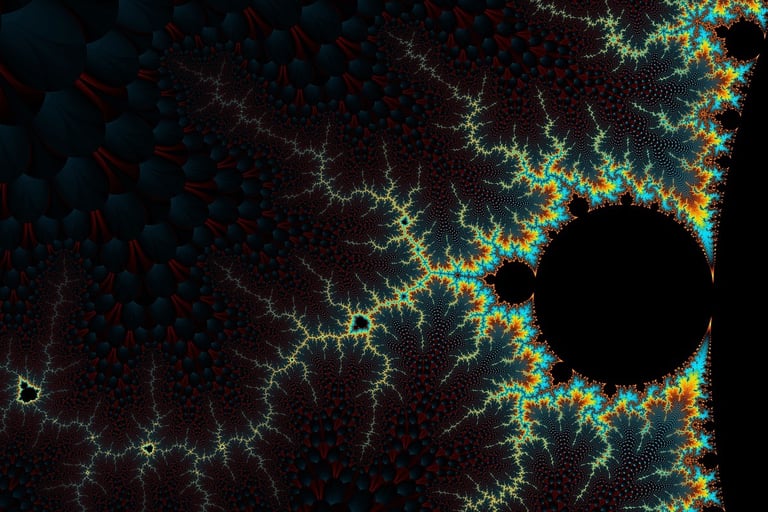🌀 Fractals and Similarity
A Page in Similarity Theory
By Simon Raphael
🌿 The Geometry of Self-Resemblance
Fractals are the visible geometry of similarity — nature’s recursive whisper that the pattern of the whole lives within every part. From the branching of trees to the meandering of rivers, from the lightning bolt to the galactic arm, the same self-similar pattern repeats across vastly different scales.
Mathematician Benoît Mandelbrot, who coined the term fractal in 1975, described them as “a way of seeing infinity.” He wrote:
“Clouds are not spheres, mountains are not cones, coastlines are not circles, and bark is not smooth.”
This observation revealed that nature’s geometry is not Euclidean but fractal — a geometry of roughness, recursion, and infinite depth.
In Similarity Theory, this fractal structure is more than aesthetic: it represents the living signature of consciousness expressed through matter and form. Creation does not copy itself; it remembers itself through repetition with variation — the hallmark of evolution and intelligence.
🔬 Fractals in Nature and Mathematics
Fractals emerge wherever energy and matter self-organise. A simple iterative rule, when repeated, can produce infinite detail — as seen in the Mandelbrot set, Koch snowflake, and Sierpiński triangle.
Physicist Richard Feynman once remarked that “nature uses only the longest threads to weave her patterns, so each small piece of her fabric reveals the organisation of the entire tapestry.” This is precisely the logic of fractality: the local reflects the global.
Natural systems exhibit fractal behaviour because they optimise flow and distribution:
Blood vessels and leaf veins maximise nutrient exchange through fractal branching.
River networks and lightning bolts trace energy paths that follow power-law scaling.
Cloud formations, mountain ranges, and even stock market fluctuations display fractal statistics.
Physicist Didier Sornette, studying fractal systems in finance and earthquakes, noted:
“Fractals are the universal language of complexity.”
These findings confirm that fractals are not exceptions but the underlying grammar of natural formation — the mathematics of emergence.
🌌 Consciousness and Infinite Reflection
In Similarity Theory, fractals represent more than geometry; they mirror the way consciousness unfolds through time. Each level of a fractal retains a trace of its origin — an imprint of memory carried forward. This mirrors how consciousness preserves identity across frames of time, evolving yet recognisably continuous.
Mathematician Roger Penrose, in The Road to Reality, suggested that “the laws of physics themselves may exhibit a recursive self-similarity,” hinting that consciousness and physical law may share the same underlying structure.
Every fractal layer represents a dimensional echo — a repetition of the same principle under new conditions. Likewise, in Similarity Theory, each dimension of reality is a new expression of consciousness, bound by familiar patterns but evolving toward greater complexity and awareness.
“Fractals remind us that the universe is not assembled—it unfolds.”
🔦 Memory of the Universe
Fractals embody memory in form. The curve of a coastline or the branching of a neuron carries the mathematical fingerprint of past iterations — a record of growth, adaptation, and constraint.
In physics, this recursive continuity appears in systems driven far from equilibrium — where patterns self-organise through feedback. Nobel laureate Ilya Prigogine described this as “order through fluctuations,” where chaos itself gives rise to structured memory.
This principle resonates with Similarity Theory’s view that consciousness evolves through repetition with remembrance. Every pattern is a story of persistence — the universe remembering itself through fractal recursion.
“The universe is self-referential — a mirror of mirrors. The fractal is its handwriting.” — Simon Raphael
🪞 The Infinite Within the Finite
To explore a fractal is to travel into infinite variation within finite boundaries. The deeper we zoom, the more the pattern reveals itself — never ending, always familiar.
This mirrors consciousness itself: the more deeply one looks inward, the more one finds reflection rather than boundary. The fractal, then, is not just a mathematical curiosity but a model of the soul’s evolution — infinite in potential, finite in expression.
Physicist Brian Greene once wrote that “self-similarity may be the simplest route by which nature generates complexity.” In Similarity Theory, this same principle extends to awareness: each soul, each mind, each dimension is a recursive echo of the same universal consciousness, exploring itself through infinite variation.
🧭 Key Insight
Fractals demonstrate that complexity arises not from chaos but from remembrance — the continual re-expression of a pattern that connects all scales of existence.
They are the visible trace of similarity, written in the geometry of reality itself.
🔗 Related Pages
⏳ [Frames of Time] — explores how moments echo across scales of consciousness.
🌌 [Dimensions] — examines layered realities and how patterns scale through dimensional rules.
🧠 [Consciousness] — introduces the foundation of awareness from which all patterns arise.
🧩 [Mathematical Structures] — connects abstract form to natural geometry.
🌀 [Patterns] — reveals the recurring logic that underpins both matter and mind
📚 References
Mandelbrot, B. (1982). The Fractal Geometry of Nature. W.H. Freeman.
Feynman, R. (1963). The Character of Physical Law. MIT Press.
Sornette, D. (2006). Critical Phenomena in Natural Sciences. Springer.
Penrose, R. (2004). The Road to Reality. Vintage Books.
Prigogine, I. (1980). From Being to Becoming: Time and Complexity in the Physical Sciences.
Greene, B. (1999). The Elegant Universe.
Raphael, S. (2025). Similarity Theory — The Geometry of Consciousness.



